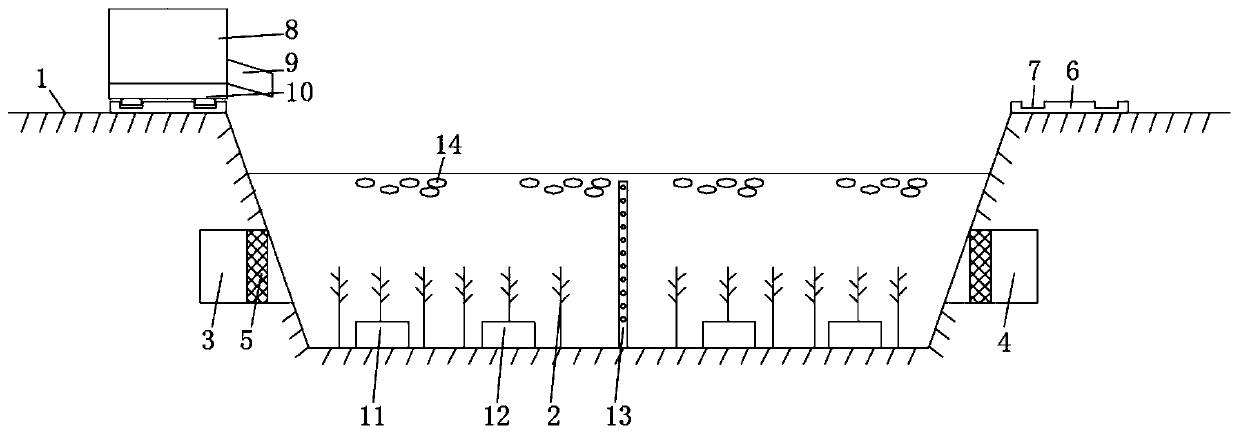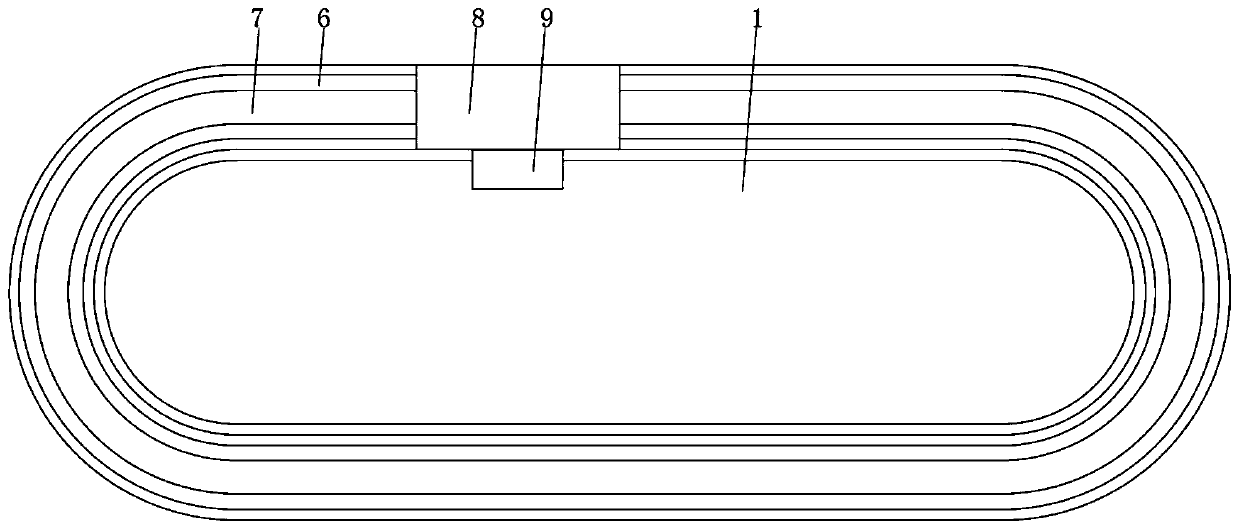Special high-density Australia lobster breeding pond and method
A technology of Australian lobster and cultivation method, which is applied in high-density Australian lobster special cultivation pond and cultivation field, can solve the problem of low yield per mu of lobster, and achieve the effect of simple and easy cultivation method, good feeding quality and accurate operation.
- Summary
- Abstract
- Description
- Claims
- Application Information
AI Technical Summary
Problems solved by technology
Method used
Image
Examples
Embodiment 1
[0052] A method for cultivating high-density Australian lobsters, comprising the following steps:
[0053] A: Pond preparation: clean up the silt at the bottom of the pond 1, sprinkle quicklime for disinfection, then expose the bottom of the pond 1 to the sun for 2 days, then install the water quality testing mechanism 11, the sterilization mechanism 12 and the oxygen delivery pipe 13 on the bottom of the pond 1, and then Open the valve in the water inlet pipe 3 to inject water, close the valve in the water inlet pipe 3 when the water depth reaches 2 / 3, then plant the underwater vegetation 2 and the floating vegetation 14, the underwater vegetation 2 includes Elodea, Hydrilla verticillium, goldfish Any combination of one or more of algae and polygrass, the underwater vegetation 2 accounts for 30% of the area of the pond 1, the floating vegetation 14 includes water peanuts and water hyacinth, and the floating vegetation 14 accounts for 20% of the area of the pond 1;
[0054...
Embodiment 2
[0060] A method for cultivating high-density Australian lobsters, comprising the following steps:
[0061] A: Pond preparation: clean up the silt at the bottom of the pond 1, sprinkle quicklime for disinfection, then expose the bottom of the pond 1 to the sun for 3 days, then install the water quality testing mechanism 11, the sterilization mechanism 12 and the oxygen delivery pipe 13 on the bottom of the pond 1, and then Open the valve in the water inlet pipe 3 to inject water, close the valve in the water inlet pipe 3 when the water depth reaches 2 / 3, then plant the underwater vegetation 2 and the floating vegetation 14, the underwater vegetation 2 includes Elodea, Hydrilla verticillium, goldfish Any combination of one or more of algae and grass, the underwater vegetation 2 accounts for 40% of the area of the pond 1, the floating vegetation 14 includes water peanuts and water hyacinth, and the floating vegetation 14 accounts for 30% of the area of the pond 1;
[0062] B:...
Embodiment 3
[0068] A method for cultivating high-density Australian lobsters, comprising the following steps:
[0069] A: Pond preparation: clean up the silt at the bottom of the pond 1, sprinkle quicklime for disinfection, then expose the bottom of the pond 1 to the sun for 4 days, then install the water quality testing mechanism 11, the sterilization mechanism 12 and the oxygen delivery pipe 13 on the bottom of the pond 1, and then Open the valve in the water inlet pipe 3 to inject water, close the valve in the water inlet pipe 3 when the water depth reaches 2 / 3, then plant the underwater vegetation 2 and the floating vegetation 14, the underwater vegetation 2 includes Elodea, Hydrilla verticillium, goldfish Any combination of one or more of algae and grass, the underwater vegetation 2 accounts for 50% of the area of the pond 1, the floating vegetation 14 includes water peanuts and water hyacinth, and the floating vegetation 14 accounts for 40% of the area of the pond 1;
[0070] B:...
PUM
 Login to View More
Login to View More Abstract
Description
Claims
Application Information
 Login to View More
Login to View More - R&D
- Intellectual Property
- Life Sciences
- Materials
- Tech Scout
- Unparalleled Data Quality
- Higher Quality Content
- 60% Fewer Hallucinations
Browse by: Latest US Patents, China's latest patents, Technical Efficacy Thesaurus, Application Domain, Technology Topic, Popular Technical Reports.
© 2025 PatSnap. All rights reserved.Legal|Privacy policy|Modern Slavery Act Transparency Statement|Sitemap|About US| Contact US: help@patsnap.com



